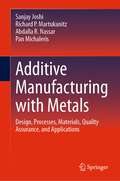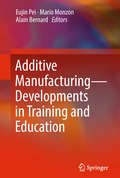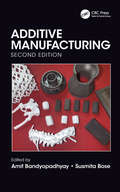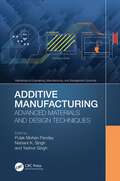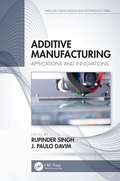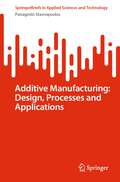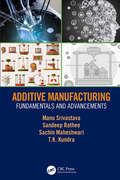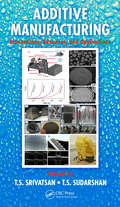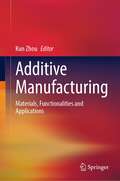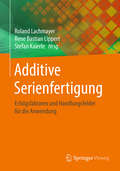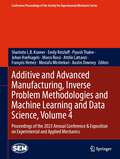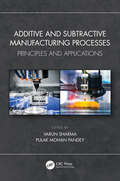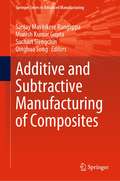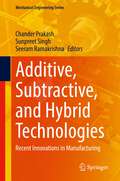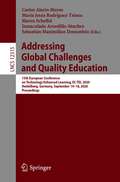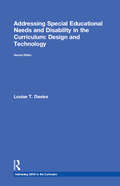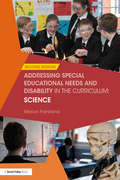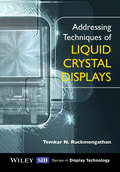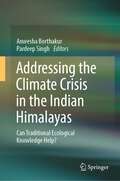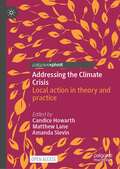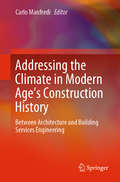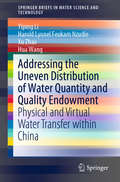- Table View
- List View
Additive Manufacturing with Medical Applications
by Rajendra M. BelokarThis reference text discusses integrated approaches to improve the objectives of additive manufacturing in medical application. The text covers case studies related to product design and development, discuses biomaterials, applications of artificial intelligence and machine learning using additive manufacturing techniques. It covers important topics including 3D printing technology, materials for 3D printing in medicine, rapid prototyping in clinical applications, and use of additive manufacturing in customized bone tissue engineering scaffold. The text- Discusses additive manufacturing techniques and their utilization in medical applications. Covers important applications of additive manufacturing in the fields of medicine, education and space industry. Explores regulatory challenges associated with the emergence of additive manufacturing. Examines the use of rapid prototyping in clinical applications. The text will serve as a useful reference guide for graduate students and academic researchers in the fields of industrial engineering, manufacturing science, mechanical engineering, and aerospace engineering. This book discusses important application areas of additive manufacturing, including medicine, education, and the space industry, this reference text will be a serve as a useful text for graduate students and academic researchers in the fields of industrial engineering, manufacturing science, mechanical engineering, and aerospace engineering.
Additive Manufacturing with Metals: Design, Processes, Materials, Quality Assurance, and Applications
by Sanjay Joshi Richard P. Martukanitz Abdalla R. Nassar Pan MichalerisThis textbook and reference provides a comprehensive treatment of additive manufacturing (AM) for metals, including design and digital work flows, process science and reliability, metallic systems, quality assurance, and applications. The book is rooted in the fundamental science necessary to develop and understand AM technologies, as well as the application of engineering principles covering several disciplines to successfully exploit this important technology. As additive manufacturing of metals is the fastest growing subset of this transformative technology, with the potential to make the widest impact to industrial production, Metals Additive Manufacturing: Design, Processes, Materials, Quality Assurance, and Applications is ideal for students in a range of engineering disciplines and practitioners working in aerospace, automotive, medical device manufacturing industries.
Additive Manufacturing with Novel Materials: Process, Properties and Applications
by R. Rajasekar C. Moganapriya P. Sathish KumarADDITIVE MANUFACTURING With NOVEL MATERIALS The book explores practically the latest advancements and techniques in 3D and 4D printing using innovative and unconventional materials. This book comprehensively provides insights into various additive manufacturing processes, novel materials, and their properties, as well as the basic knowledge of AM process parameters, post-processing techniques, and their applications. It also explores the fundamental concepts and recent advancements in the development of novel materials for several applications, with special emphasis on platforms like AM techniques for polymers, ceramics, metallic materials, composites, nanomaterials, hydrogels, etc. Specific topics like environmental aspects of 3D printing and advanced 4D printing are also introduced. The technological aspects of AM are discussed in a concise and understandable way, with extensive illustrations. Also covered are the challenges and opportunities that arise from 3D printing with these materials. Audience The book will benefit researchers and industry engineers who work in additive manufacturing, mechanical engineering, 3D/4D printing, and materials science.
Additive Manufacturing – Developments in Training and Education
by Alain Bernard Eujin Pei Mario MonzónThis book provides an overview of training and teaching methods, as well as education strategies, for Additive Manufacturing (AM) and its application in different business sectors. It presents real-world applications and case studies to demonstrate the key practical and theoretical fundamentals of AM training, written by international experts from the field. Additive Manufacturing is a rapidly developing technology, and having a well-trained workforce is essential. Accordingly, readers are introduced to new training approaches and recent breakthroughs that can facilitate and accelerate the design, application and implementation of AM.The book’s contributors discuss many topics to provide readers a fundamental grasp of AM, including:· collaboration among educational bodies, and between industry and governments;· strategies for implementing AM training;· new teaching methods;· training programs that provide alternative employment choices;· the need for certification by professional bodies; and· promoting awareness of AM in society. This book offers an excellent source of information for researchers and industrial engineers who are interested in expanding their AM expertise, and learning how to implement it. It will also be of interest to readers who want to learn about the practicalities of adopting training and teaching for AM.
Additive Manufacturing, Second Edition
by Susmita Bose Amit BandyopadhyayThe field of additive manufacturing is growing dynamically as the interest is persisting from manufacturing sector, including other sectors as well. Conceptually, additive manufacturing is a way to build parts without using any part-specific tooling or dies from the computer-aided design (CAD) file of the part. Second edition of Additive Manufacturing highlights the latest advancements in the field, taking an application oriented approach. It includes new material on traditional polymer based rapid prototyping technologies, additive manufacturing of metals and alloys including related design issues. Each chapter comes with suggested reading, questions for instructors and PowerPoint slides.
Additive Manufacturing: Advanced Materials and Design Techniques (Mathematical Engineering, Manufacturing, and Management Sciences)
by Yashvir Singh Nishant K. Singh Pulak Mohan PandeyThe text explores the development, use, and effect of additive manufacturing and digital manufacturing technologies for diverse applications. It will serve as an ideal reference text for graduate students and academic researchers in diverse engineering fields including industrial, manufacturing, and materials science. This book: Discusses the application of 3D virtual models to lasers, electron beams, and computer-controlled additive manufacturing machines Covers applications of additive manufacturing in diverse areas including healthcare, electronics engineering, and production engineering Explains the use of additive manufacturing for biocomposites and functionally graded materials Highlights rapid manufacturing of metallic components using 3D printing Illustrates production and optimization of dental crowns using additive manufacturing This book covers recent developments in manufacturing technology, such as additive manufacturing, 3D printing, rapid prototyping, production process operations, and manufacturing sustainability. The text further emphasizes the use of additive manufacturing for biocomposites and functionally graded materials. It will serve as an ideal reference text for graduate students and academic researchers in the fields of industrial engineering, manufacturing engineering, automotive engineering, aerospace engineering, and materials science.
Additive Manufacturing: Applications and Innovations (Manufacturing Design and Technology)
by Rupinder Singh and J. Paulo DavimThere has been a great deal of progress in additive manufacturing (AM) during the past two decades and recent developments have been highlighted by many researchers. However, until now, there has been a limit to what is available for beginners in a step-by-step format, showcasing the different commercial AM technologies for field application. This book helps fill that gap. Additive Manufacturing: Applications and Innovations presents case studies of commonly used AM technologies with basic numerical problems for better understanding. It also includes hybrid processes and 4D printing applications, which currently are not offered in other AM books. Features Offers solved and unsolved problems in additive manufacturing Provides an understanding for additive manufacturing per international standards Includes case studies for better understanding of the individual processes Presents a review of specific technology highlights Introduces future research directions, mainly in 4D printing applications
Additive Manufacturing: Design, Processes and Applications (SpringerBriefs in Applied Sciences and Technology)
by Panagiotis StavropoulosThis book is a comprehensive guide to Additive Manufacturing (AM) product development. It offers a practical, reader-friendly approach to integrating the stages of product development. It covers current design and manufacturing strategies with a step-by-step approach, divided into three pillars: design, processes, and applications.The book addresses the challenges hindering the industrial application of AM and provides a roadmap for its successful implementation. It discusses specific AM case studies and hybrid AM cell and production line setups, with the goal of achieving high-quality, low-cost products that are both flexible and productive. The book concludes with an examination of Industry 4.0 capabilities in decentralized manufacturing.It is aimed to be read by researchers and professionals in industry who are interested in the development and potential of additive manufacturing, and will help to lead to wider adoption of AM.
Additive Manufacturing: Fundamentals and Advancements
by Sandeep Rathee Manu Srivastava Sachin Maheshwari Tk KundraThere is a growing need for manufacturing optimization all over the world. The immense market of Additive Manufacturing (AM) technologies dictates a need for a book that will provide knowledge of the various aspects of AM for anyone interested in learning about this fast-growing topic. This book disseminates knowledge of AM amongst scholars at graduate level, post graduate level, doctoral level, as well as industry personnel. The objective is to offer a state-of-the-art book which covers all aspects of AM and incorporates all information regarding trends, historical developments, classifications, materials, tooling, software issues, dynamic design, principles, limitations, and communication interfaces in a one-stop resource. Features: Breaks down systematic coverage of various aspects of AM within four distinct sections Contains details of various AM techniques based on ASTM guidelines Discusses many AM applications with suitable illustrations Includes recent trends in the field of AM Covers engineering materials utilized as raw materials in AM Compares AM techniques with different traditional manufacturing methods
Additive Manufacturing: Innovations, Advances, and Applications
by T. S. Srivatsan T. S. SudarshanGet Ready for the Future of Additive ManufacturingAdditive Manufacturing: Innovations, Advances, and Applications explores the emerging field of additive manufacturing (AM)-the use of 3D printing to make prototype parts on demand. Often referred to as the third industrial revolution, AM offers many advantages over traditional manufacturing. This pr
Additive Manufacturing: Materials, Functionalities and Applications
by Kun ZhouThis book focuses on the advances of additive manufacturing in the applications of wearable electronics, energy storage, biomedical implants and devices, drug delivery, and technologies for 4D printing, large-scale printing, and ceramics printing. It provides timely insights into the materials, functionalities, and applications of additive manufacturing.
Additive Serienfertigung: Erfolgsfaktoren und Handlungsfelder für die Anwendung
by Roland Lachmayer Rene Bastian Lippert Stefan KaierleBei der additiven Fertigung wird anders als bei konventionellen Verfahren ein Bauteil nicht aus einem Block herausgefräst oder in einem Werkzeug gegossen, sondern es wird Schicht für Schicht generiert. Dieses Buch stellt eine Vielzahl verschiedener Aspekte der additiven Fertigung vor und erläutert anhand von Praxisbeispielen die Anwendungen und die Potenziale der Verfahren für eine Serienfertigung: Wo und wie kann die additive Fertigung erfolgreich eingesetzt werden?Die Autoren zeigen vor dem Hintergrund eines ganzheitlichen Entwicklungs- und Fertigungsprozesses mögliche Geschäftsmodelle auf, unter anderem die Fertigung in Microfactories. Leser erfahren, wie sich die Fertigungszeit und -kosten vorhersagen lassen, wie zuverlässig additiv gefertigte Strukturbauteile sind und inwieweit additive Fertigungsverfahren für die Herstellung von Endprodukten geeignet sind.Ferner diskutieren die Autoren, wie Pre- und Post-Prozesse genutzt werden können, um Serienanwendungen zu etablieren und diese iterativ zu verbessern. Neben den Möglichkeiten zur Qualitätssicherung bei der additiven Serienfertigung wird erläutert, wann es sinnvoll sein kann, konventionelle Fertigungsverfahren durch hybride Ansätze zu ergänzen. Die additive Instandsetzung als Alternative zum Entsorgen von verschlissenen Bauteilen wird ebenfalls erörtert. Im Hinblick auf eine Effizienzsteigerung diskutieren die Autoren Sicherheitsaspekte und legen Lösungsansätze bei Problemen im Umgang mit der additiven Serienfertigung dar.
Additive and Advanced Manufacturing, Inverse Problem Methodologies and Machine Learning and Data Science, Volume 4: Proceedings of the 2023 Annual Conference & Exposition on Experimental and Applied Mechanics (Conference Proceedings of the Society for Experimental Mechanics Series)
by Marco Rossi Sharlotte L. B. Kramer Johan Hoefnagels François Hemez Emily Retzlaff Piyush Thakre Attilio Lattanzi Mostafa Mirshekari Austin DowneyAdditive and Advanced Manufacturing, Inverse Problem Methodologies and Machine Learning and Data Science, Volume 4 of the Proceedings of the 2023 SEM Annual Conference & Exposition on Experimental and Applied Mechanics, the fourth volume of five from the Conference, brings together contributions to this important area of research and engineering. The collection presents early findings and case studies on a wide range of topics and includes papers in the following general technical research areas: AM Composites and Polymers Dynamic Behavior of Additively Manufactured Materials and Structures Joint Residual Stress and Additive Manufacturing ML for Material Model Identification Novel AM Structures Novel Processing and Testing of Additively Manufactured Materials Plasticity and Complex Material Behavior Virtual Fields Method
Additive and Subtractive Manufacturing Processes: Principles and Applications
by Varun Sharma Pulak Mohan PandeyThis reference text discusses fundamentals, classification, principles, applications of additive and subtractive manufacturing processes in a single volume. The text discusses 3D printing techniques with the help of practical case studies, covers rapid tooling using microwave sintering and ultrasonic assisted sintering process, and covers different hybrid manufacturing techniques like cryo-MQL, and textured cutting inserts. It covers important topics including green manufacturing, ultrasonic assisted machining, electro thermal based non-conventional machining processes, metal based additive manufacturing, LASER based additive manufacturing, indirect rapid tooling, and polymer based additive manufacturing. The book- Discusses additive and subtractive manufacturing processes in detail. Covers hybrid manufacturing processes. Provides life cycle analysis of conventional machining. Discusses biomedical and industrial applications of additive manufacturing. The text will be useful for senior undergraduate, graduate students, and academic researchers in areas including industrial and manufacturing engineering, mechanical engineering, and production engineering. Discussing the sustainability aspects of conventional machining in reducing carbon footprint of machining by adopting different hybrid and non-conventional machining processes, this text will be useful for senior undergraduate, graduate students, and academic researchers in areas including industrial and manufacturing engineering, mechanical engineering, and production engineering.
Additive and Subtractive Manufacturing of Composites (Springer Series in Advanced Manufacturing)
by Munish Kumar Gupta Suchart Siengchin Sanjay Mavinkere Rangappa Qinghua SongThis book describes crucial aspects related to the additive and subtractive manufacturing of different composites. The first half of this book mainly deals with the various types of composite fabrication methods along with the introduction, features and mechanisms and also the processing of composite materials via additive manufacturing route. Also, the thermal, mechanical, physical and chemical properties relevant to the processing of composite materials are included in the chapters. The second half of this book primarily demonstrates an extensive section on the different types of additive manufacturing processes like selective laser sintering, selective laser melting, stereolithography, fused deposition modeling and material jetting used to fabricate the metals and polymers. Also, the chapters address the complete description of fabrication processes for metal matrix composites and polymer matrix composites. Moreover, the different methods adopted such as short peening, micro-machining, heat-treatment and solution treatment to improve the surface improvement are well discussed. This book gives many helps to researchers and students in the fields of the additive and subtractive manufacturing of different composites.
Additive, Subtractive, and Hybrid Technologies: Recent Innovations in Manufacturing (Mechanical Engineering Series)
by Seeram Ramakrishna Chander Prakash Sunpreet SinghThis book provides readers with the comprehensive insights of the recent research breakthroughs in additive, subtractive, and hybrid technologies. Further, the book examines incomparable design and manufacturing independences, as well as strategies to upgrade the product performance characteristics through collaborating additive and subtractive technologies. Indeed, the intrinsic benefits and limitations of both additive and subtractive manufacturing technologies could be merged to obtain appreciable hybridizations. The editorial team members and contributors to Additive, Subtractive, and Hybrid Technologies are highly motivated experts committed to and the advance of hybrid manufacturing technologies.
Addressing Emerging Trends to Support the Future of Criminal Justice: Findings of the Criminal Justice Technology Forecasting Group
by Richard Silberglitt Brian A. Jackson John S. Hollywood Dulani Woods Andrew LaulandThe Criminal Justice Technology Forecasting Group (CJTFG) deliberated on the effects that major technology and social trends could have on criminal justice in the next two to five years and identified potential responses. This report captures the results of the group’s meetings and initiatives, presents the emerging trends and highlights of the group’s discussion, and presents the results of analyses to assess connections between the trends.
Addressing Global Challenges and Quality Education: 15th European Conference on Technology Enhanced Learning, EC-TEL 2020, Heidelberg, Germany, September 14–18, 2020, Proceedings (Lecture Notes in Computer Science #12315)
by Maren Scheffel María Jesús Rodríguez-Triana Carlos Alario-Hoyos Inmaculada Arnedillo-Sánchez Sebastian Maximilian DennerleinThis book constitutes the proceedings of the 15th European Conference on Technology Enhanced Learning, EC-TEL 2020, held in Heidelberg, Germany, in September 2020. The 24 research papers and 20 demo and 5 poster papers presented in this volume were carefully reviewed and selected from 91 submissions. The European Conference on Technology-Enhance Learning, which celebrates its 15th anniversary this year, is committed to address global challenges and quality education. The papers deal with the Sustainable Development Goals, particularly SDG 4 and SDG 10, to help to reduce the existing gaps and inequalities between countries and regions from around the world in terms of inclusiveness, equity, access, and quality of education.The chapters: “Designing an Online Self-Assessment for Informed Study Decisions: The User Perspective”; “Living with Learning Difficulties: Two Case Studies Exploring the Relationship Between Emotion and Performance in Students With Learning Difficulties”; “Applying Instructional Design Principles on Augmented Reality Cards for Computer Science Education”; and “Teaching Simulation Literacy With Evacuations - Concept, Technology, and Material for a Novel Approach” are available open access under a Creative Commons Attribution 4.0 International License via link.springer.com. Due to the Corona pandemic EC-TEL 2020 was held as an virtual event.
Addressing Special Educational Needs and Disability in the Curriculum: Design And Technology (Addressing SEND in the Curriculum)
by Louise T. DaviesThe SEND Code of Practice (2015) reinforced the requirement that all teachers must meet the needs of all learners. This topical book provides practical, tried-and-tested strategies and resources that will support teachers in making design and technology lessons accessible and interesting for all pupils, including those with special educational needs. The author draws on a wealth of experience to share her understanding of special educational needs and disabilities and show how the design and technology teacher can reduce or remove any barriers to learning. Offering strategies that are specific to the context of design and technology teaching, this book will enable teachers to: better identify a student’s particular learning requirements; set inclusive design and making assignments which allow all students to participate and succeed; build students’ confidence in using a range of materials and tools; assist with design tasks where pupils take ownership of their work and learning; adapt the classroom environment to meet the needs of pupils; create a mutually supportive classroom which maximises learning opportunities. An invaluable tool for continuing professional development, this text will be essential for design and technology teachers (and their teaching assistants) seeking to include and motivate all pupils in their lessons, regardless of their individual needs. This book will also be of interest to secondary SENCOs, senior management teams and ITT providers. In addition to free online resources, a range of appendices provide design and technology teachers with a variety of pro forma and activity sheets to support effective teaching. This is an essential tool for design and technology teachers and teaching assistants, and will help to deliver successful, inclusive lessons for all pupils.
Addressing Special Educational Needs and Disability in the Curriculum: Science (Addressing SEND in the Curriculum)
by Marion FranklandThe SEND Code of Practice (2015) reinforced the requirement that all teachers must meet the needs of all learners. This topical book provides practical, tried and tested strategies and resources that will support teachers in making science lessons accessible and exciting for all pupils, including those with special needs. The author draws on a wealth of experience to share her understanding of special educational needs and disabilities and show how science teachers can reduce or remove any barriers to learning. Offering strategies that are specific to the context of science teaching, this book will enable teachers to: help all students develop their ‘evidence-gathering’ skills and aid their scientific discovery by involving the use of all of the senses and structuring tasks appropriately; create a supportive environment that maximises learning opportunities; plan the classroom layout and display to enhance learning; use technology to adapt lessons to the needs of individual pupils; successfully train and fully use the support of their teaching assistants. An invaluable tool for continuing professional development, this text will be essential for teachers (and their teaching assistants) seeking guidance specific to teaching science to all pupils, regardless of their individual needs. This book will also be of interest to SENCOs, senior management teams and ITT providers. In addition to free online resources, a range of appendices provide science teachers with a variety of writing frames and activity sheets to support effective teaching. This is an essential tool for science teachers and teaching assistants, and will help to deliver successful, inclusive lessons for all pupils.
Addressing Techniques of Liquid Crystal Displays
by Temkar N. RuckmongathanUnique reference source that can be used from the beginning to end of a design project to aid choosing an appropriate LCD addressing technique for a given application This book will be aimed at design engineers who are likely to embed LCD drivers and controllers in many systems including systems on chip. Such designers face the challenge of making the right choice of an addressing technique that will serve them with best performance at minimal cost and complexity. Readers will be able to learn about various methods available for driving matrix LCDs and the comparisons at the end of each chapter will aid readers to make an informed design choice. The book will address the various driving techniques related to LCDs. Due to the non-linear response of the liquid crystal to external voltages, different driving methods such as passive and active matrix driving can be utilized. The associated theoretical basis of these driving techniques is introduced, and this theoretical analysis is supplemented by information on the implementation of drivers and controllers to link the theory to practice. Written by an experienced research scientist with over 30 years in R&D in this field. Acts as an exhaustive review and comparison of techniques developed for passive-matrix addressing of twisted nematic and super-twisted nematic (STN) LCDs. Discusses the trend towards "High Definition" displays and that a hybrid approach to drive matrix LCDs (combination of active and passive matrix addressing) will be the future of LCD addressing. Contains the author's recent work on Bit-Slice Addressing that is useful for fast responding LCDs, as well as a chapter on driving ferroelectric LCDs Provides an objective comparison that will enable designers to make an informed choice of an addressing technique for a specific application. Includes examples of the practical applications of addressing techniques. Organised in a way that each chapter can be read independently; with the basic knowledge and historical background gained from the introductory chapters, adequate for understanding the techniques that are presented in the remaining chapters making it a self-contained reference.
Addressing the Climate Crisis in the Indian Himalayas: Can Traditional Ecological Knowledge Help?
by Pardeep Singh Anwesha BorthakurThis book focuses on the traditional ecological knowledge in addressing the current climate crisis in the Indian Himalayas. Local or indigenous people in the Himalayas, through their low-carbon producing lifestyles, contribute very little to the climate crisis. However, at the same time, they bear the brunt of this crisis way more than many others. It is important to learn about their traditional ways of life and the knowledge that they hold regarding ecology and environment. Traditional ecological knowledge and associated belief systems are given increasing attention across the globe in recent times toward addressing some of the grave environmental concerns. Climate change is one such concern. The rising consideration of concepts such as ethnoecology and ethnobotany signifies the scientific, socio-cultural and economic potential of the traditional ecological knowledge systems. It is indisputable that these knowledge systems have the ability to provide important insights towards tackling many present-day environmental distresses including several climate change challenges. In this book, the authors concentrate on such traditional ecological knowledge systems in the Indian Himalayan region and try to figure out their significance in relation to the modern science. Overall, the authors attempt to write a book where the relevance of traditional ecological knowledge systems could be addressed and communicated to a larger audience—both academic scientific and non-academic.
Addressing the Climate Crisis: Local action in theory and practice
by Amanda Slevin Matthew Lane Candice HowarthThis open access book brings together a collection of cutting-edge insights into how action can and is already being taken against climate change at multiple levels of our societies, amidst growing calls for transformative and inclusive climate action. In an era of increasing recognition regarding climate and ecological breakdown, this book offers hope, inspiration and analyses for multi-level climate action, spanning varied communities, places, spaces, agents and disciplines, demonstrating how the energy and dynamism of local scales are a powerful resource in turning the tide. Interconnected yet conceptually distinct, the book’s three sections span multiple levels of analysis, interrogating diverse perspectives and practices inherent to the vivid tapestry of climate action emerging locally, nationally and internationally. Delivered in collaboration with the UK’s ‘Place-Based Climate Action Network’, chapters are drawn from a wide range of authors with varying backgrounds spread across academia, policy and practice.
Addressing the Climate in Modern Age's Construction History: Between Architecture and Building Services Engineering (SpringerBriefs in Applied Sciences and Technology)
by Carlo ManfrediThis book sheds light on environmental control in buildings from the 17th century onwards. Even before building services became a hallmark of buildings, in order to address increasing sanitary and comfort needs, pioneering experiences had contributed to improve design skills of professionals. After long being determined by passive features, indoor climate became influenced by installations and plants, representing the most significant shift of paradigm in the modern age’s construction history. This change was not without consequences, and the book presents contributions showing the deep connection between architectural design, comfort requirements and environmental awareness throughout the 19th century. Taking into account the differences between different European countries, the book is a valuable resource for architects, designers and heritage professionals who are interested in environmental design, enabling them to develop a deeper knowledge of heritage in order to address to climate demands, particularly going towards a future in which energy savings and fuel consumption reduction will dictate our behaviour. It includes contributions by leading international experts: Melanie Bauernfeind, Marco Cofani, Lino Vittorio Bozzetto, Emmanuelle Gallo, Alberto Grimoldi, Dean Hawkes, Angelo Giuseppe Landi, Mattias Legnér, Oriel Prizeman, and Henrik Schoenefeldt.
Addressing the Uneven Distribution of Water Quantity and Quality Endowment: Physical and Virtual Water Transfer within China (SpringerBriefs in Water Science and Technology)
by Hua Wang Yiping Li Xu Zhao Harold Lyonel Feukam NzudieThis book presents a selected literature review and case studies for both physical and virtual water transfer. It offers an overview to showcase the interprovincial physical and virtual water transfer within China, and then demonstrates the effects of both approaches in dealing with regional water scarcity; the three cases presented in the Yangtze River Basin demonstrate the role of physical water transfer in improving water quality and restoring water ecosystems; while a Shanghai case highlights the impact of Shanghai’s virtual water import on water quantity and quality stress to other regions. This book promotes systematic approaches combining both virtual and physical water transfer solutions to deal with water quantity and quality issues. The book is intended for senior undergraduates, graduate students, lecturers and researchers in water management.

